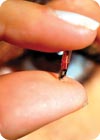
Implanted microchips can help find dogs, identify expensive racehorses, can track newborns and now are starting to provide identity, tracking and access for employees and other people.
Dogs do it. Horses do it. llama and alpaca even do it.
Goats? Sheep? Miniature pigs? Rabbits? Deer? Ferrets? Sure, they all do it, too.
But what about Aunt Mary or newborn Shawn? Should they do it?
Welcome to the controversial, but to some, wonderful world of the microchip.
A microchip implant is an identifying integrated circuit placed under the skin. The chips are about the size of a large grain of rice and based on passive radio frequency identification (RFID) technology. These inert devices contain no internal power source. They’re designed so that they do not act until acted upon.
Microchips implanted into animals can verify them when lost or sold. The technology is perfect for such applications.
Three basic elements comprise most microchips:
A silicon chip (integrated circuit), a core of ferrite wrapped in copper wire and a small capacitor. The silicon chip contains data plus electronic circuits to relay that information to a scanner. The ferrite or iron core acts as a radio antenna, ready to receive a signal from the scanner. The capacitor acts as a tuner, forming a circuit with the antenna coil.

Microcips, such as the VeriChip, consist of a silicon chip (integrated circuit), a core of ferrite wrapped in copper wire and a small capacitor.
Glass Capsule
For implanting into live subjects, these components are encased in special biocompatible glass made from soda lime and hermetically sealed to prevent any moisture or fluid entering the unit.For years, animal owners have embraced these chips to identify lost dogs or to verify real expensive racehorses, as two examples. Vets contend that animals are not affected physically or behaviorally by the presence of these little chips in their bodies. Still, some studies suggest that the chips can migrate inside an animal’s body.
More recently, microchip vendors, a handful of businesses and even whole countries are, to varying degrees, advocating injecting microchips into people to identify infants if they are kidnapped, to alert to a wandering patient, as a fraud-proof payment method or even to open a door into a sensitive facility area.
For people, the microchip implant is mostly medically safe, while some suggest, that similar to animal studies, the chip could move around the body over the course of time or in certain situations. Such chips last for 10-15 years but the process of removal is difficult.
But the obvious controversy falls into four concern areas: the invasiveness of the approach, privacy issues, the perceived link to Nazi-like tattoos and the “mark of the beast” fear shared by some people based on their religious beliefs.
Still, in the United States, three recent actions indicate that, for some applications, microchip implants are closer to reality if not total acceptance.
The U.S. Department of Defense (DoD), for example, has recently awarded $1.6 million to the Center for Bioelectronics, Biosensors and Biochips (C3B) at Clemson University for development of what the DoD calls an implantable biochip that could relay vital health information if a soldier is wounded in battle or a civilian is hurt in an accident. For the military, it would replace so-called “dog-tags” that carry limited amount of personal information. Appropriate personnel, equipped with a portable reader, could more quickly gather useful information or quickly tie into a local or remote database.
The biochip could measure and relay such information as lactate and glucose levels in the event of a major hemorrhage, whether on the battlefield, at home or on the highway, for instance.

Hundreds of thousands of dogs have been injected with a microchip, often from AVID, so that in case of loss, they can be identified if found.
Monitoring Health
Anthony Guiseppi-Elie, C3B director and Dow Chemical Professor of Chemical and Biomolecular Engineering and professor of bioengineering, said first responders to a trauma scene could inject the biochip into the wounded victim and gather data almost immediately. The device has other long-term potential applications such as monitoring astronauts’ vital signs during long-duration space flights and reading blood-sugar levels for diabetics.“We now lose a large percentage of patients to bleeding, and getting vital information such as how much oxygen is in the tissue back to ER physicians and medical personnel can often mean the difference between life and death,” said Guiseppi-Elie. “Our goal is to improve the quality and expediency of care for fallen soldiers and civilian trauma victims.” The biochip also may be injected as a precaution to future traumas, he added.
Clemson scientists have formulated a gel that mimics human tissue and reduces the chances of the body rejecting the chip, which has been a problem in the past. The researcher predicts the chip is five years away from human trials in such healthcare applications.
Almost at the same time this year, the American Medical Association’s Council on Ethical and Judicial Affairs adopted a policy stating that implantable radio frequency identification devices may help to identify patients, thereby improving the safety and efficiency of patient care, and may be used to enable secure access to patient clinical information.
The bottom line: Implanted microchips can provide logical access control.
About three years before the AMA position paper, the Food and Drug Administration opened the door by giving approval to a microchip (the VeriChip from Applied Digital Solutions of Delray Beach, Fla.) implanted under the skin to give doctors instant access to a patient’s records. In such an application, the capsule transmits a unique code to a scanner to let doctors confirm a patient’s identity and obtain detailed medical information from a computer-linked database.
The solution works.
Just weeks ago, the technology was successfully used at Hackensack University Medical Center in Hackensack, N.J., helping a Bergen County Police Officer, who previously received the VeriChip during an emergency situation. The event represented the first time that a patient who had received it was able to receive treatment from a hospital that also offered the system.

Horses, some worth millions of dollars, have implanted microchips so that they can be better identified when sold.
Medical History at Arm
Hackensack’s emergency room medical staff had immediate, secure access to Sgt. William Koretsky’s identity and medical history after scanning his microchip and linking it with the officer’s patient information file stored on a secure database. Koretsky, a Bergen County Police officer, was taken to Hackensack University Medical Center with head, neck and back injuries after a high-speed chase that resulted in a car accident. He consented to disclosing his name and information about the incident to the media including Security Magazine so that others could know of the benefits of having medical records rapidly available.“As a police officer involved in high-risk situations, incidents such as my experience at Hackensack University Medical Center highlight the important role that the VeriChip can play in situations where it is critical for emergency room personnel to access medical conditions and history. As a result of my previously receiving the VeriChip and Hackensack’s emergency room having a patient identification system, I was able to receive faster treatment during the critical time period when I arrived at the hospital,” said Koretsky.
Leading an aggressive marketing effort, Applied Digital Solutions markets the VeriChip systems -- the chips, scanners and computerized database -- to hospitals, doctors and patients as a way to improve care and avoid errors by ensuring that doctors know whom they are treating and the patient’s personal health details. Emergency room doctors could scan unconscious accident victims to check blood type and medications and make sure they have no drug allergies. Surgeons could scan patients in the operating room to guard against cutting into the wrong person. Chips could be implanted in Alzheimer’s patients in case they get lost.

Some parents, fearing the kidnapping of their newborns, have implanted microchips in their babies so that – if they are recovered looking different in a number of years – can be identified.
Beyond Medical Needs
Beyond healthcare, VeriChip seems to be going where some others fear to tread.But critics fear endangering patient privacy. The Big Brother scenario: citizens and employees will be tracked by the implants or required to have them inserted for surveillance, identification and other purposes. More than a million VeriChips track livestock, cats, dogs and other pets. Still it is suggested that a little more than a thousand people have had a mircochip implant.
According to media reports, Mexico’s attorney general claimed he had one of the devices injected into his arm, as had about 160 of his lieutenants. The application was to control access to high-security offices. In clubs in Amsterdam and Barcelona, patrons supposedly can have the chips implanted to allow them to enter exclusive areas and keep track of their tabs.
The bottom line: Wireless technologies, RFID development, new software solutions, smart card applications and under skin implants might one day come together as another solution for law enforcement and enterprises. A person can lose an access control card or a credit card, but it is more rare to lose an arm containing the microchip.
More generally, privacy advocates and some state legislators, primarily in California, have expressed concerns about chip, token and card-based RFID, suggesting that unauthorized people could pick off personal information as it flies through the air. The animal and human microchip applications have very short read ranges. So it’s a long shot that an interloper could come within three to 12 or so inches to capture information. In addition, for VeriChip and other RFID card designs, most often what flies through the air is a number that relates to a separate, much harder to access database.
Scott Silverman of VeriChip says the primary aim is to help high-risk medical patients such as those with diabetes, Alzheimer’s, cancer and heart conditions. He has been quoted in the media as saying that “It should be first and foremost voluntary. No one should ever be forced to get an implantable microchip.”

People now see value in microchip implants. Most often injected into an arm, the procedure costs about $200. There are healthcare, wandering patient and even physical access control applications.
Fear in Chips
Others are less confident in the human application of the implanted microchip.Katherine Albrecht, a co-author of Spychips, has been quoted as saying the writing is on the wall that VeriChip is taking us down a treacherous road. “If everybody had a chip in them, we would be blissfully unaware of big brother,” she has been quoted. Still, it is extraordinarily remote that “everybody” will have an implanted microchip one day.
Silverman has pointed out that, once a person has been chipped, the device could be used for other applications beyond healthcare records or wandering patient needs.
There are first adopters, of course. John Halamka, an emergency physician at Boston’s Beth Israel Deaconess Medical Center, carried a microchip inside him. It is aimed primarily at personal healthcare records, although he has been quoted that he has “lost my anonymity.”

Some people oppose implanting microchips in people out of fear of the mark of the beast, in which they believe the devil is involved. Other critics see an invasion of privacy.
SIDEBAR: Mark of the Beast
There is an ever widening confusion and misunderstanding among Christians over the identification of the mark of the beast. Some contend it is received in a person’s hand or in a person’s forehead or through a credit card, laser mark or a microchip implant, or even a national identification number. Connected with the above is the belief that if any of God’s people possess or are in any way connected with the above items, then they have received the “mark” of this beast and are lost.SIDEBAR: What is Privacy?
Privacy has no definite boundaries with different meanings for different people. It is the ability of an individual or group to keep their lives and personal affairs out of public view, or to control the flow of information about themselves. Privacy is sometimes related to anonymity although it is often most highly valued by people who are publicly known. Privacy can be seen as an aspect of security — one in which trade-offs between the interests of one group and another can become particularly clear.The right against unsanctioned invasion of privacy by the government, corporations or individuals is part of many countries’ laws, and in some cases, constitutions or privacy laws. In the United States, the Supreme Court has stitched together privacy from several constitutional sources. The federal Privacy Act of 1974 set requirements of federal agencies to protect federal information. A number of states have a more literal rights of privacy.
Privacy may be voluntarily sacrificed, normally in exchange for perceived benefits, but often with little benefit and very often with specific dangers and losses. An example of voluntary sacrifice is entering a sweepstakes or competitions. A person gives personal details (often for advertising purposes) in order to have a chance of winning a prize. Another example is where information voluntarily shared is later stolen or misused such as in identity theft.
The latest privacy concern is a flip on previous threats. Enterprises and institutions that have allowed employee or student records to be lost or stolen have been liable for privacy invasion.
